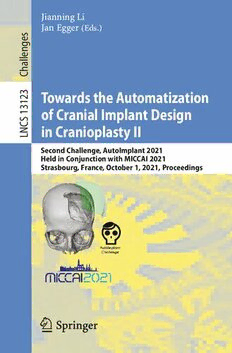
Towards the Automatization of Cranial Implant Design in Cranioplasty II: Second Challenge, AutoImplant 2021, Held in Conjunction with MICCAI 2021, ... PDF
Preview Towards the Automatization of Cranial Implant Design in Cranioplasty II: Second Challenge, AutoImplant 2021, Held in Conjunction with MICCAI 2021, ...
Jianning Li Jan Egger (Eds.) s e g n e l l a h C 3 Towards the Automatization 2 1 3 of Cranial Implant Design 1 S C in Cranioplasty II N L Second Challenge, AutoImplant 2021 Held in Conjunction with MICCAI 2021 Strasbourg, France, October 1, 2021, Proceedings Lecture Notes in Computer Science 13123 FoundingEditors GerhardGoos KarlsruheInstituteofTechnology,Karlsruhe,Germany JurisHartmanis CornellUniversity,Ithaca,NY,USA EditorialBoardMembers ElisaBertino PurdueUniversity,WestLafayette,IN,USA WenGao PekingUniversity,Beijing,China BernhardSteffen TUDortmundUniversity,Dortmund,Germany GerhardWoeginger RWTHAachen,Aachen,Germany MotiYung ColumbiaUniversity,NewYork,NY,USA Moreinformationaboutthissubseriesathttps://link.springer.com/bookseries/7412 · Jianning Li Jan Egger (Eds.) Towards the Automatization of Cranial Implant Design in Cranioplasty II Second Challenge, AutoImplant 2021 Held in Conjunction with MICCAI 2021 Strasbourg, France, October 1, 2021 Proceedings Editors JianningLi JanEgger GrazUniversityofTechnology GrazUniversityofTechnology Graz,Austria Graz,Austria UniversityHospitalEssen UniversityHospitalEssen Essen,Germany Essen,Germany ISSN 0302-9743 ISSN 1611-3349 (electronic) LectureNotesinComputerScience ISBN 978-3-030-92651-9 ISBN 978-3-030-92652-6 (eBook) https://doi.org/10.1007/978-3-030-92652-6 LNCSSublibrary:SL6–ImageProcessing,ComputerVision,PatternRecognition,andGraphics ©SpringerNatureSwitzerlandAG2021 Thisworkissubjecttocopyright.AllrightsarereservedbythePublisher,whetherthewholeorpartofthe material is concerned, specifically the rights of translation, reprinting, reuse of illustrations, recitation, broadcasting, reproduction on microfilms or in any other physical way, and transmission or information storageandretrieval,electronicadaptation,computersoftware,orbysimilarordissimilarmethodologynow knownorhereafterdeveloped. Theuseofgeneraldescriptivenames,registerednames,trademarks,servicemarks,etc.inthispublication doesnotimply,evenintheabsenceofaspecificstatement,thatsuchnamesareexemptfromtherelevant protectivelawsandregulationsandthereforefreeforgeneraluse. Thepublisher,theauthorsandtheeditorsaresafetoassumethattheadviceandinformationinthisbookare believedtobetrueandaccurateatthedateofpublication.Neitherthepublishernortheauthorsortheeditors give a warranty, expressed or implied, with respect to the material contained herein or for any errors or omissionsthatmayhavebeenmade.Thepublisherremainsneutralwithregardtojurisdictionalclaimsin publishedmapsandinstitutionalaffiliations. ThisSpringerimprintispublishedbytheregisteredcompanySpringerNatureSwitzerlandAG Theregisteredcompanyaddressis:Gewerbestrasse11,6330Cham,Switzerland Preface Different countries can have difference clinical practices of cranioplasty - a surgical proceduretorepaircranialdefects.Forsomecountriesandclinicalinstitutes,acranial implant is the primary choice for the repairment of cranial defects. However, the designandmanufacturingofcranialimplants,especiallypatient-specificimplants(PSIs), remains time-consuming and expensive. Hence, current workflows of cranioplasty demandimprovements. The second AutoImplant cranial implant design challenge (AutoImplant 2021, https://autoimplant2021.grand-challenge.org/) was organized as a satellite event of the Medical Image Computing and Computer Assisted Interventions (MICCAI 2021) conference,focusingspecificallyontheclinicalusabilityoftheautomaticcranialimplant designalgorithms.Thus,threetasktrackswerecreatedforAutoImplant2021;Task1 and Task 3 focused on the generalization ability of the algorithms on varied synthetic defectpatterns,asweobservedfromtheprioreditionofthechallengethatimproving thegeneralizationabilityisnon-trivial,yetessentialfortheproblemofautomaticcranial implant design. Task 2 provided 11 pre-cranioplasty skulls with real defects from the clinicalroutineforaclinicalevaluationofthealgorithms.Clinicalexpertswereinvited tomanuallyassesstheclinicalusabilityofthepredictionsforTask2basedonascoring system ranging from 1 point (not usable) to 5 points (flawless). The conference was held virtually on October 1, 2021, and featured 11 talks, including two invited talks fromGermanandAmericanneurosurgeonswhospecializeincranioplastyandcranial implantdesign. Thechallengeproceedingsarecomprisedof10papers(8–18pageslong),including oneinvitedpaperfromclinicalexpertsaboutcranioplastymanagement.Adescriptorfor thecreationoftheTask1datasetwasalsoprovidedbytheorganizingteammembers. Clinicalexperts’evaluationsfortheTask2submissionswerecompiledasanindependent paper,aswebelievethequalitativeevaluationcriteriausedbyclinicalexpertsarevaluable tothe(automatic)cranialimplantdesigncommunitysincegeneralquantitativemetrics alonearenotcloselycorrelativeoftheactualpracticalusabilityofthecranialimplants. Thechallengepaperswerereviewedinasingle-blindmannerandeachchallengepaper receivedthreetofourreviews.Itwasrequiredthat,forthecamera-readyversionofthe acceptedpapers,thereviewers’commentsmustbeaddressedandincorporated.There isonepaperthatgotacceptedafteramajorrevision. Wearegratefultotheorganizingteammembers,theauthors,andthespeakersfor makingourconferenceasuccess,andforcontributingtotheadvancementofautomatic cranialimplantdesign. October2021 JianningLi JanEgger Organization GeneralChairs JianningLi Graz University of Technology and Medical University of Graz,AustriaandUniversityHospitalEssen,Germany JanEgger Graz University of Technology and Medical University of Graz,AustriaandUniversityHospitalEssen,Germany ChallengeCommitteeandCo-organizers MicheleR.Aizenberg UniversityofNebraskaMedicalCenter,USA VictorAlves UniversityofMinho,Portugal DavidG.Ellis UniversityofNebraskaMedicalCenter,USA OldˇrichKodym BrnoUniversityofTechnology,CzechRepublic KarinPistracher MedicalUniversityofGraz,Austria MichalŠpaneˇl BrnoUniversityofTechnology,CzechRepublic GordvonCampe MedicalUniversityofGraz,Austria Sponsors TESCAN3DIMJointVenture(https://www.tescan3dim.com/) CAMed:Clinicaladditivemanufacturingformedicalapplications (https://www.medunigraz.at/camed/) viii Organization Acknowledgements The challenge received the support of CAMed - Clinical additive manufacturing for medical applications (COMET K-Project 871132), which is funded by the Austrian Federal Ministry of Transport, Innovation and Technology (BMVIT), the Austrian FederalMinistryforDigitalandEconomicAffairs(BMDW),andtheStyrianBusiness PromotionAgency(SFG).Furthermore,thechallengehadthesupportoftheAustrian ScienceFund(FWF)KLI678-B31:“enFaced:VirtualandAugmentedRealityTraining and Navigation Module for 3D-Printed Facial Defect Reconstructions”. We also want to thank the Computer Algorithms for Medicine Laboratory (https://cafe-lab.org/) members and the paper reviewers. Finally, we thank Zhaodi Deng for the design of theoriginalchallengelogo. Contents PersonalizedCalvarialReconstructioninNeurosurgery ..................... 1 LaurèlRauschenbach,ChristophRieß,UlrichSure,andKarstenH.Wrede QualitativeCriteriaforFeasibleCranialImplantDesigns .................... 8 DavidG.Ellis,CarlosM.Alvarez,andMicheleR.Aizenberg SegmentationofDefectiveSkullsfromCTDataforTissueModelling ......... 19 OldrˇichKodym,MichalŠpaneˇl,andAdamHerout Improving the Automatic Cranial Implant Design in Cranioplasty byLinkingDifferentDatasets ........................................... 29 MarekWodzinski,MateuszDaniol,andDariaHemmerling LearningtoRearrangeVoxelsinBinarySegmentationMasksforSmooth ManifoldTriangulation ................................................. 45 JianningLi,AntonioPepe,ChristinaGsaxner,YuanJin,andJanEgger AU-NetBasedSystemforCranialImplantDesignwithPre-processing andLearnedImplantFiltering ........................................... 63 HamzaMahdi, AllisonClement, EvanKim, ZacharyFishman, CariM.Whyne,JamesG.Mainprize,andMichaelR.Hardisty SparseConvolutionalNeuralNetworkforSkullReconstruction .............. 80 ArtemKroviakov,JianningLi,andJanEgger CranialImplantPredictionbyLearninganEnsembleofSlice-BasedSkull CompletionNetworks .................................................. 95 BokaiYang,KeFang,andXingyuLi PCA-Skull: 3D Skull Shape Modelling Using Principal Component Analysis ............................................................. 105 LeiYu,JianningLi,andJanEgger Cranial Implant Design Using V-Net Based Region of Interest Reconstruction ........................................................ 116 ShashwatPathak,ChitimireddySindhura,RamaKrishnaSaiS.Gorthi, DegalaVenkataKiran,andSubrahmanyamGorthi AuthorIndex ......................................................... 129 Personalized Calvarial Reconstruction in Neurosurgery B LaurèlRauschenbach( ),ChristophRieß,UlrichSure,andKarstenH.Wrede DepartmentofNeurosurgeryandSpineSurgery,UniversityHospitalEssen,Hufelandstrasse55, 45147Essen,Germany [email protected] Abstract. Neurosurgical procedures often involve local skull bone removal to combatspecificpathologies.Defectcoveringismandatoryinmostcasesandusu- ally requires the application of bespoke and synthetically engineered implants. Sincemanufacturingmanagementfacesseveralbarriersinthedesign,fabrication, andapplicationprocess,thereisanunmetneedforimprovement.Inthisarticle, theauthorsreviewthebackgroundofskullboneremovalandcalvarialreconstruc- tion techniques, highlight the challenges on the horizon, and investigate future pathways. Keywords: Craniectomy·Cranioplasty·Personalizedmedicine·Implant· Neurosurgery 1 IndicationsforCraniectomy Craniectomyisthesurgicalremovalofbonefromtheskull.Inmostcases,livingwith a cranial bone defect is temporary. In a follow-up surgery, the removed bone flap can either be reimplanted or the defect can be covered using synthetically manufactured implants[1,2].Thereasonsforcraniectomyaremanifold,involvingnumerousdifferent pathologies. Mostcommonly,craniectomyaimstodecompress,relievingthemasseffectofbrain swellinganddecreasingelevatedintracranialpressure.Brainswellingconstitutesalife- threateningemergencyandisoftentheresultofbleedingoredemaderivingfrominfarc- tion,traumaticbraininjury,cerebralhypoxia,intracerebralhemorrhage,cerebralvenous thrombosis, or encephalitis [3, 4]. Notably, the idea of decompressive craniectomy is notnew.Centuriesago,AlexanderMonroandGeorgeKelliefirstdescribedtherelation- shipbetweenintracranialcontentandintracranialpressure.Afterseveralrevisions,this conceptlaterbecameknownastheMonro-Kelliedoctrine[5].Thisprinciplestatesthat thesumofbrainvolume,intracranialcerebrospinalfluid,andintracranialbloodmustbe constanttoensureanequilibriumofphysiologicalintracranialpressure.Anincreasein onevolumeshouldcauseareciprocaldecreaseintheremainingcomponents;Otherwise, theintracranialpressurewillrise.Thus,brainswellingalwaysdisplacescerebrospinal fluid and blood out of the skull to create space. However, given the small volume of intracranial cerebrospinal fluid and blood, these compliance mechanisms are usually ©SpringerNatureSwitzerlandAG2021 J.LiandJ.Egger(Eds.):AutoImplant2021,LNCS13123,pp.1–7,2021. https://doi.org/10.1007/978-3-030-92652-6_1
